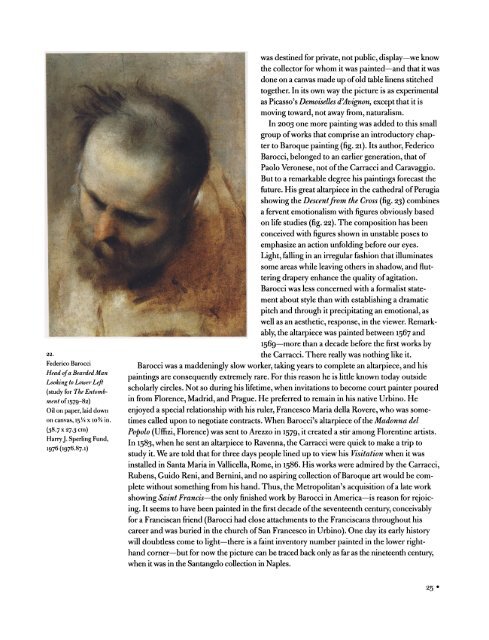GOING FOR BAROQUE Into the Bin - The Metropolitan Museum of Art
GOING FOR BAROQUE Into the Bin - The Metropolitan Museum of Art
GOING FOR BAROQUE Into the Bin - The Metropolitan Museum of Art
You also want an ePaper? Increase the reach of your titles
YUMPU automatically turns print PDFs into web optimized ePapers that Google loves.
22.<br />
Federico<br />
Head<br />
Looking<br />
(study<br />
ment<br />
Barocci<br />
a<br />
<strong>of</strong><br />
Bearded Man<br />
to Lower<br />
Left<br />
for <strong>The</strong> Entomb<br />
<strong>of</strong>1579-82)<br />
Oil on paper, laid down<br />
on canvas,<br />
(38.7x27.3<br />
15 lA x 10% in.<br />
cm)<br />
Harry J. Sperling Fund,<br />
1976 (1976.87.1)<br />
was destined for private,<br />
not public, display?we<br />
know<br />
<strong>the</strong> collector for whom it was<br />
painted?and<br />
that it was<br />
done on a canvas made up <strong>of</strong> old table linens stitched<br />
toge<strong>the</strong>r.<br />
In its own way <strong>the</strong> picture<br />
is as experimental<br />
as Picasso's Demoiselles<br />
d'Avignon, except that it is<br />
moving toward, not<br />
away from, naturalism.<br />
In 2003 one more<br />
was<br />
painting<br />
added to this small<br />
group <strong>of</strong> works that comprise<br />
an introductory chap<br />
ter to Baroque painting (fig. 21).<br />
Its author, Federico<br />
Barocci, belonged<br />
to an earlier generation,<br />
that <strong>of</strong><br />
Paolo Veronese, not <strong>of</strong> <strong>the</strong> Carracci and Caravaggio.<br />
But to a remarkable<br />
degree<br />
his paintings<br />
forecast <strong>the</strong><br />
future. His great altarpiece<br />
in <strong>the</strong> ca<strong>the</strong>dral <strong>of</strong> Perugia<br />
showing<br />
<strong>the</strong> Descent<br />
from <strong>the</strong> Cross<br />
(fig. 23) combines<br />
a fervent emotionalism with<br />
figures obviously<br />
based<br />
on life studies<br />
(fig. 22). <strong>The</strong> composition<br />
has been<br />
conceived with<br />
figures<br />
shown in unstable poses to<br />
an<br />
emphasize<br />
action<br />
unfolding<br />
before our<br />
eyes.<br />
Light, falling<br />
in an irregular<br />
fashion that illuminates<br />
some areas while<br />
leaving<br />
o<strong>the</strong>rs in shadow, and flut<br />
tering drapery<br />
enhance <strong>the</strong> quality<br />
<strong>of</strong> agitation.<br />
Barocci was less concerned with a formalist state<br />
ment about<br />
style<br />
than with<br />
a<br />
establishing<br />
dramatic<br />
pitch<br />
and<br />
through<br />
it an precipitating emotional, as<br />
well as an aes<strong>the</strong>tic, response, in <strong>the</strong> viewer. Remark<br />
ably,<br />
<strong>the</strong> altarpiece<br />
was<br />
painted between 1567 and<br />
1569?more than a decade before <strong>the</strong> first works<br />
by<br />
<strong>the</strong> Carracci. <strong>The</strong>re<br />
really was nothing<br />
like it.<br />
Barocci was a maddeningly<br />
slow worker, taking years<br />
to complete<br />
an altarpiece, and his<br />
are rare.<br />
paintings consequently extremely<br />
For this reason he is little known<br />
today outside<br />
scholarly<br />
circles. Not so during<br />
his lifetime, when invitations to become court painter poured<br />
in from Florence, Madrid, and Prague.<br />
He<br />
preferred<br />
to remain in his native Urbino. He<br />
a<br />
enjoyed special relationship<br />
with his ruler, Francesco Maria della Rovere, who was some<br />
times called upon to negotiate<br />
contracts. When Barocci's<br />
altarpiece<br />
<strong>of</strong> <strong>the</strong> Madonna del<br />
was<br />
Pop?lo (Uffizi, Florence)<br />
sent to Arezzo in 1579, it created a stir among Florentine artists.<br />
In 1583, when he sent an altarpiece<br />
to Ravenna, <strong>the</strong> Carracci were<br />
quick<br />
to make a trip<br />
to<br />
study<br />
it. We are told that for three days people lined up to view his Visitation when it was<br />
installed in Santa Maria in Vallicella, Rome, in 1586. His works were admired<br />
by<br />
<strong>the</strong> Carracci,<br />
Rubens, Guido Reni, and Bernini, and no aspiring<br />
collection <strong>of</strong> Baroque<br />
art would be com<br />
plete without something<br />
from his hand. Thus, <strong>the</strong> <strong>Metropolitan</strong>'s acquisition<br />
<strong>of</strong> a late work<br />
showing<br />
Saint Francis?<strong>the</strong><br />
only<br />
finished work<br />
by Barocci in America?is reason for rejoic<br />
ing.<br />
It seems to have been painted<br />
in <strong>the</strong> first decade <strong>of</strong> <strong>the</strong> seventeenth century, conceivably<br />
for a Franciscan friend<br />
(Barocci<br />
had close attachments to <strong>the</strong> Franciscans<br />
throughout<br />
his<br />
career and was buried in <strong>the</strong> church <strong>of</strong> San Francesco in Urbino).<br />
One<br />
day<br />
its early history<br />
will doubtless come to light?<strong>the</strong>re<br />
is a faint<br />
inventory<br />
number<br />
painted<br />
in <strong>the</strong> lower<br />
right<br />
hand corner?but for now <strong>the</strong> can picture<br />
be traced back as only<br />
far as <strong>the</strong> nineteenth century,<br />
when it was in <strong>the</strong> Santangelo<br />
collection in Naples.<br />
25*
















